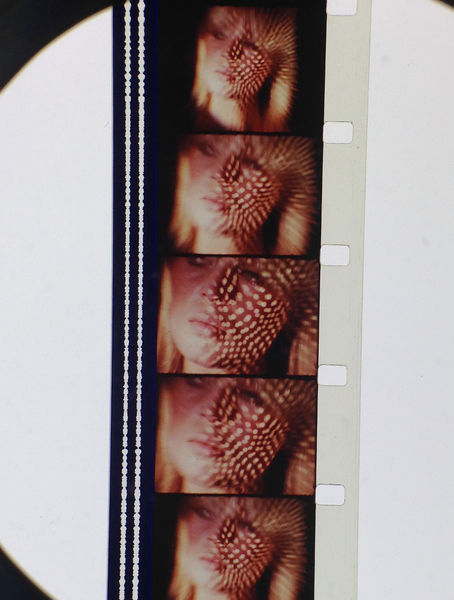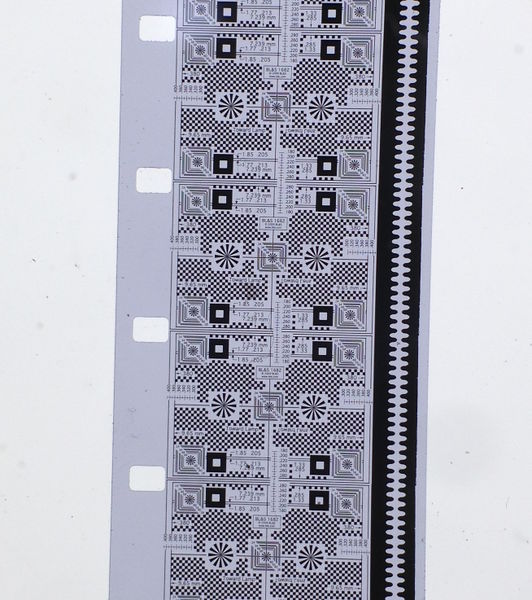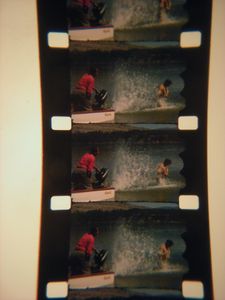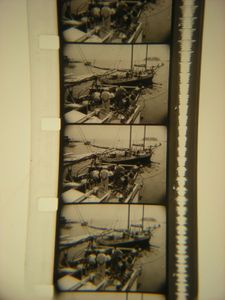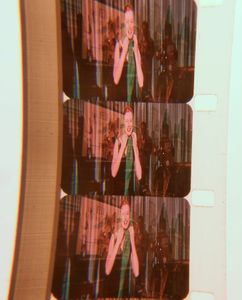| Welcome to Sprocket School! This project is maintained by volunteer editors. Learn more about how this works. |
16mm: Difference between revisions
No edit summary |
No edit summary |
||
| Line 5: | Line 5: | ||
*aspect ratios | *aspect ratios (super 16, anamorphic prints) | ||
*single perf or double perf | *single perf or double perf | ||
*emulsion in or out | *emulsion in or out | ||
| Line 12: | Line 12: | ||
The [[16mm]] frame has a native full-frame aspect ratio of ~1.34:1. This is the aspect ratio of the vast majority of 16mm prints. | The [[16mm]] frame has a native full-frame aspect ratio of ~1.34:1. This is the aspect ratio of the vast majority of 16mm prints. | ||
Other 16mm aspect ratios exist, however. Some prints are hard-matted to widescreen aspect ratios like 1.85 and 1.66 (this is seen with some frequency on 16mm reductions of widescreen feature films originally released on 35mm). | Other 16mm aspect ratios exist, however. Some prints are hard-matted to widescreen aspect ratios like 1.85 and 1.66 (this is seen with some frequency on 16mm reductions of widescreen feature films originally released on 35mm). The same lens and plate is used for hard matted 16mm prints, you'll just see black on the top and bottom of the image on screen. | ||
Anamorphic 16mm prints also exist. These have an aspect ratio of 2.66:1 (because of the native 1.33 aspect ratio of the frame). Note that this means that anamorphic 16mm reductions of films originally released as 35mm anamorphic will be cropped slightly at the top and bottom of the frame! | Anamorphic 16mm prints also exist. These have an aspect ratio of 2.66:1 (because of the native 1.33 aspect ratio of the frame). Note that this means that anamorphic 16mm reductions of films originally released as 35mm anamorphic will be cropped slightly at the top and bottom of the frame! Proper projection of anamorphic 16mm prints require an anamorphic lens. | ||
16mm was historically used for the distribution of Hollywood releases to nontheatrical venues (schools, prisons, summer camps, etc.) as well as for television broadcast. Further variations related to aspect ratio crop up on prints that were used for these purposes. These include simple cropping of widescreen or CinemaScope images to 16mm's native 1.33 as well as "[http://en.wikipedia.org/wiki/Pan_and_scan pan and scan]" efforts. | 16mm was historically used for the distribution of Hollywood releases to nontheatrical venues (schools, prisons, summer camps, etc.) as well as for television broadcast. Further variations related to aspect ratio crop up on prints that were used for these purposes. These include simple cropping of widescreen or CinemaScope images to 16mm's native 1.33 as well as "[http://en.wikipedia.org/wiki/Pan_and_scan pan and scan]" efforts. | ||
| Line 34: | Line 34: | ||
==Resources== | ==Resources== | ||
* [http://16mmdirectory.org/ 16mm Directory] | * [http://16mmdirectory.org/ 16mm Directory] | ||
*[http://www.paulivester.com/films | *[http://www.paulivester.com/films/ 16mm film stock identification and more] | ||
* Just a warning that while the [http://www.iupress.indiana.edu/product_info.php?products_id=807587/ Advanced Projection Manual] is a great resource for 35mm and 70mm film projection, it is fairly dismissive and lacking in information regarding small gauge projection. | |||
[[Category:Film prints]] | [[Category:Film prints]] | ||
[[Category:Film gauges]] | [[Category:Film gauges]] | ||
Revision as of 19:25, 9 February 2017
-
A few frames from a 16mm print of Chelsea Girls.
-
16mm test film.
- aspect ratios (super 16, anamorphic prints)
- single perf or double perf
- emulsion in or out
- sound formats
16mm Aspect Ratios
The 16mm frame has a native full-frame aspect ratio of ~1.34:1. This is the aspect ratio of the vast majority of 16mm prints.
Other 16mm aspect ratios exist, however. Some prints are hard-matted to widescreen aspect ratios like 1.85 and 1.66 (this is seen with some frequency on 16mm reductions of widescreen feature films originally released on 35mm). The same lens and plate is used for hard matted 16mm prints, you'll just see black on the top and bottom of the image on screen.
Anamorphic 16mm prints also exist. These have an aspect ratio of 2.66:1 (because of the native 1.33 aspect ratio of the frame). Note that this means that anamorphic 16mm reductions of films originally released as 35mm anamorphic will be cropped slightly at the top and bottom of the frame! Proper projection of anamorphic 16mm prints require an anamorphic lens.
16mm was historically used for the distribution of Hollywood releases to nontheatrical venues (schools, prisons, summer camps, etc.) as well as for television broadcast. Further variations related to aspect ratio crop up on prints that were used for these purposes. These include simple cropping of widescreen or CinemaScope images to 16mm's native 1.33 as well as "pan and scan" efforts.
-
Conventional full frame 16mm print without soundtrack
-
Conventional full frame 16mm print with soundtrack
-
Anamorphic 16mm print
Sound Formats

Related Articles
- 16mm projectors
- List of analog film exhibitors
- test films See 16mm test film
Resources
- 16mm Directory
- 16mm film stock identification and more
- Just a warning that while the Advanced Projection Manual is a great resource for 35mm and 70mm film projection, it is fairly dismissive and lacking in information regarding small gauge projection.
